-
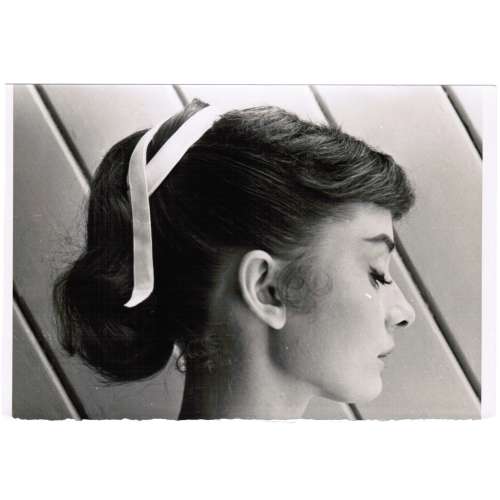 Audrey Hepburn [Audrey Kathleen Ruston] (British, 1929 – 1993) black and white head-shot in profile to right, pre-production photo testing hairstyle. "War and Peace", a 1956 epic historical drama film based on Leo Tolstoy's 1869 novel of the same name. Stamp on verso: Blue ink, in oval, "AUDREY | HEPBURN | The Personal Collection Part III | May 2018 | CHRISTIE'S || Size: 12.0 x 17.5 cm sheet; 12.0 x 16.7 cm image. Condition: small abrasion to cheek and rough lower edge. Certificate of authenticity from John Reznikoff, University Archives.
Audrey Hepburn [Audrey Kathleen Ruston] (British, 1929 – 1993) black and white head-shot in profile to right, pre-production photo testing hairstyle. "War and Peace", a 1956 epic historical drama film based on Leo Tolstoy's 1869 novel of the same name. Stamp on verso: Blue ink, in oval, "AUDREY | HEPBURN | The Personal Collection Part III | May 2018 | CHRISTIE'S || Size: 12.0 x 17.5 cm sheet; 12.0 x 16.7 cm image. Condition: small abrasion to cheek and rough lower edge. Certificate of authenticity from John Reznikoff, University Archives. -
 Black and white photographic half-length portrait of Fred Astaire [Frederick Austerlitz] (American, 1899 – 1987) in sailor's uniform, signed "Fred Astaire" in black ink. Probably, from "Following the Fleet", a 1936 American RKO musical comedy. Size: 26.2 x 20.6 cm sheet; 23.3. x 19.3 cm image. Certificate of authenticity from John Reznikoff, University Archives.
Black and white photographic half-length portrait of Fred Astaire [Frederick Austerlitz] (American, 1899 – 1987) in sailor's uniform, signed "Fred Astaire" in black ink. Probably, from "Following the Fleet", a 1936 American RKO musical comedy. Size: 26.2 x 20.6 cm sheet; 23.3. x 19.3 cm image. Certificate of authenticity from John Reznikoff, University Archives. -
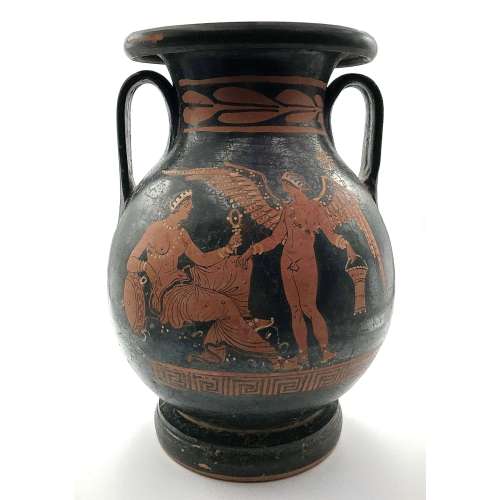 Seller provided description:"Finely painted via the red-figure technique, an elegant pelike vessel of a classic globular form with a cylindrical neck rising to a flared rim, and twin fluted handles, all upon a raised, concave, disc foot.Side A depicts a winged Eros who stands in contrapposto facing toward the left, in the nude save sandals, bracelets, a beaded sash, and a stephane (wreath) holding a situla (pail) in his left hand and gesturing toward the seated maenad before him. Though with her breasts exposed, the maenad does wear a lower garment, and is bedecked with a stephane, multiple bracelets, and strands of pearls around her neck - all delineated in fugitive white and yellow pigment. She holds a mirror in her left upraised hand and leans upon a tambourine with her right elbow. Above and to the right is a maker's mark of a circular format with a central X that is further adorned by nested wedges and dot motifs. Side B presents two opposing standing draped male figures, the gent on the left leaning upon a walking stick. Complementing the figural program, is a lovely decorative program adorning both sides of the vessel, with bands of laurel leaves above and a repeating Greek key/meander below. An outstanding example, masterfully wheel thrown, so that we see absolutely no signs of any jogs in the transitions between the different elements of the vase. Moreover, it presents ideal proportions perfect for presenting the superb painted iconographic/decorative program. The painting was executed with the utmost skill and artistry - the red-figure technique enabling the artist to delineate the figures' musculature, facial details, as well as the cascading drapery folds with extensive fugitive paint embellishments.Expected surface wear with some scuffs and pigment losses commensurate with age, but the painted program is generally very well preserved. Area of repair/restoration to cloak of male on right (Side B). Minute nick to left of male on left (Side B). Nice root marks throughout and areas of encrustation. Thermoluminescence (TL) report: the piece has been found to be ancient and of the period stated. Equivalent age: 2400 +/- 300 years. Certificate of Authenticity from Artemis Gallery. Provenance: private East Coast, USA collection. Greece, Southern Italy, Apulia, ca. 330 BCE.Size: 6.75" in diameter x 9.875" H (17.1 cm x 25.1 cm)Polina de Mauny, being both attentive and knowledgeable, was the first who noticed a possible mistake in the description above. It is highly probable that the woman on side A is not a maenad but Aphrodite herself, holding a mirror and leaning on a shield. Maenads were "often portrayed as inspired by Dionysus into a state of ecstatic frenzy through a combination of dancing and intoxication". The situla, held by Eros, unequivocally alludes to Dionysian ritual, which has to do as much with maenads as with Aphrodite. The nature of two men on side B remain unclear.
Seller provided description:"Finely painted via the red-figure technique, an elegant pelike vessel of a classic globular form with a cylindrical neck rising to a flared rim, and twin fluted handles, all upon a raised, concave, disc foot.Side A depicts a winged Eros who stands in contrapposto facing toward the left, in the nude save sandals, bracelets, a beaded sash, and a stephane (wreath) holding a situla (pail) in his left hand and gesturing toward the seated maenad before him. Though with her breasts exposed, the maenad does wear a lower garment, and is bedecked with a stephane, multiple bracelets, and strands of pearls around her neck - all delineated in fugitive white and yellow pigment. She holds a mirror in her left upraised hand and leans upon a tambourine with her right elbow. Above and to the right is a maker's mark of a circular format with a central X that is further adorned by nested wedges and dot motifs. Side B presents two opposing standing draped male figures, the gent on the left leaning upon a walking stick. Complementing the figural program, is a lovely decorative program adorning both sides of the vessel, with bands of laurel leaves above and a repeating Greek key/meander below. An outstanding example, masterfully wheel thrown, so that we see absolutely no signs of any jogs in the transitions between the different elements of the vase. Moreover, it presents ideal proportions perfect for presenting the superb painted iconographic/decorative program. The painting was executed with the utmost skill and artistry - the red-figure technique enabling the artist to delineate the figures' musculature, facial details, as well as the cascading drapery folds with extensive fugitive paint embellishments.Expected surface wear with some scuffs and pigment losses commensurate with age, but the painted program is generally very well preserved. Area of repair/restoration to cloak of male on right (Side B). Minute nick to left of male on left (Side B). Nice root marks throughout and areas of encrustation. Thermoluminescence (TL) report: the piece has been found to be ancient and of the period stated. Equivalent age: 2400 +/- 300 years. Certificate of Authenticity from Artemis Gallery. Provenance: private East Coast, USA collection. Greece, Southern Italy, Apulia, ca. 330 BCE.Size: 6.75" in diameter x 9.875" H (17.1 cm x 25.1 cm)Polina de Mauny, being both attentive and knowledgeable, was the first who noticed a possible mistake in the description above. It is highly probable that the woman on side A is not a maenad but Aphrodite herself, holding a mirror and leaning on a shield. Maenads were "often portrayed as inspired by Dionysus into a state of ecstatic frenzy through a combination of dancing and intoxication". The situla, held by Eros, unequivocally alludes to Dionysian ritual, which has to do as much with maenads as with Aphrodite. The nature of two men on side B remain unclear. -
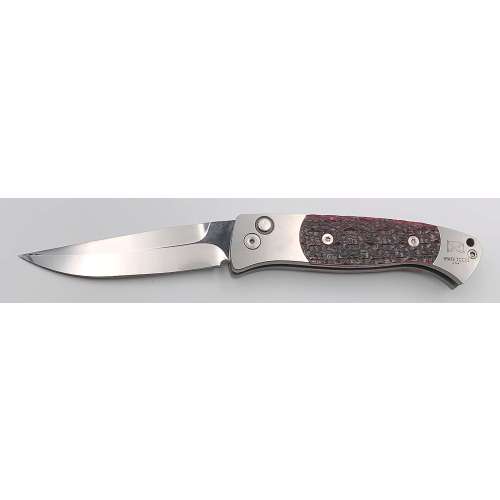
Pro-tech Walter Brend custom switchblade knife with solid 416 stainless steel frame, amber jigged bone inlays, mirror polished 154-CM blade.
Size: 94 mm (closed); 168 mm (opned); 74 mm blade)
-
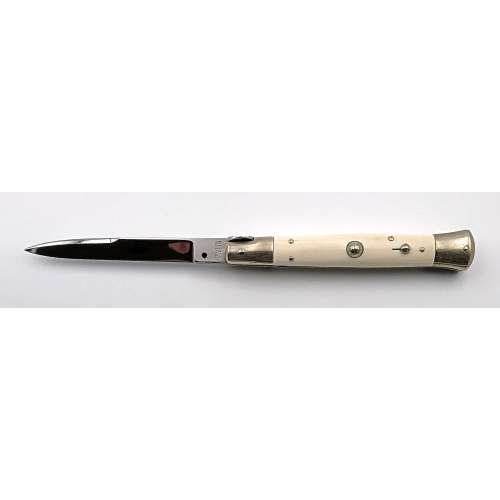
Classical picklock bayonet switchblade knife with bolster release, fixed guard, cream handles (ivory?).
Size: 123 mm x 20 mm (closed); 220 mm (opened); 130 mm blade.
Tang is etched with: Havlin. -
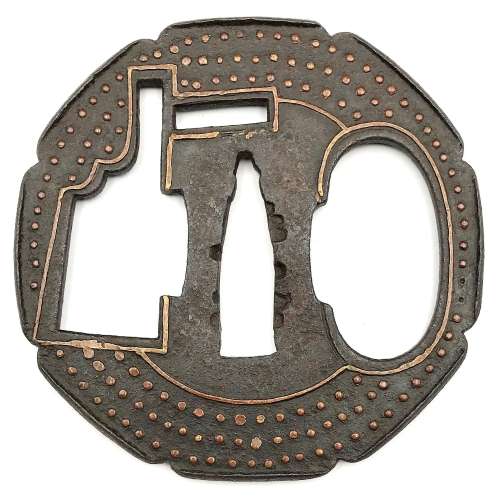 Iron tsuba of octafoil form with design of rudder (kaji) and lake in openwork (sukashi) outlined with brass wire. Thin plate also decorated with three concentric circular rows of brass dots (nail heads) in ten-zōgan. Center of the plate outlined with the inlaid circular brass wire. Cut-outs for kozuka and kogai probably added later. Slightly raised rim between the indentations (suki-nokoshi-mimi). The inlaid metal of red-ish hue, so it may be copper, not brass. Sekigane, visible on the NBTHK paper photo, are missing, possibly removed by a previous owner. Muromachi period. Ōnin school. Unsigned. Dimensions: 81.2 mm x 81.8 mm x 2.7 mm. Weight: 79.0 g. Large nakago-ana: 34 mm high and 10 mm wide. NBTHK certificate №455786: Hozon. Note regarding design: it was quite hard to interpret the big oval opening. The first suggestion was 'sea cucubmer', and it was based on a design published by Kazutaro Torigoye [Kodogu and tsuba. International collections not published in my books (Toso Soran), 1978] on page 202: Katchūshi tsuba: Sea cucumber and butterfly. Look and judge yourself:The second suggestion - 'lake' - came from [Iron tsuba. The works of the exhibition "Kurogane no hana", The Japanese Sword Museum, 2014], page 14 №5:
Iron tsuba of octafoil form with design of rudder (kaji) and lake in openwork (sukashi) outlined with brass wire. Thin plate also decorated with three concentric circular rows of brass dots (nail heads) in ten-zōgan. Center of the plate outlined with the inlaid circular brass wire. Cut-outs for kozuka and kogai probably added later. Slightly raised rim between the indentations (suki-nokoshi-mimi). The inlaid metal of red-ish hue, so it may be copper, not brass. Sekigane, visible on the NBTHK paper photo, are missing, possibly removed by a previous owner. Muromachi period. Ōnin school. Unsigned. Dimensions: 81.2 mm x 81.8 mm x 2.7 mm. Weight: 79.0 g. Large nakago-ana: 34 mm high and 10 mm wide. NBTHK certificate №455786: Hozon. Note regarding design: it was quite hard to interpret the big oval opening. The first suggestion was 'sea cucubmer', and it was based on a design published by Kazutaro Torigoye [Kodogu and tsuba. International collections not published in my books (Toso Soran), 1978] on page 202: Katchūshi tsuba: Sea cucumber and butterfly. Look and judge yourself:The second suggestion - 'lake' - came from [Iron tsuba. The works of the exhibition "Kurogane no hana", The Japanese Sword Museum, 2014], page 14 №5:
Torigoye: sea cucumber and butterfly.
Opening on my tsuba looks more like the 'lake'. Also, rudder and lake make more sense than rudder and sea cucumber. At least to me...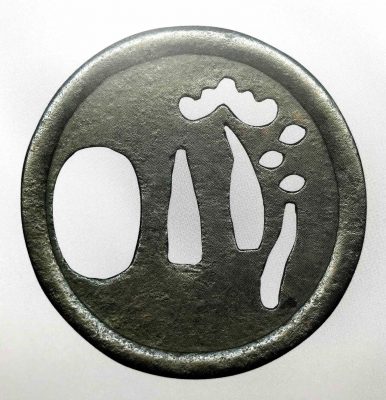
Ko-Katchūshi tsuba: Lake and pine.
-
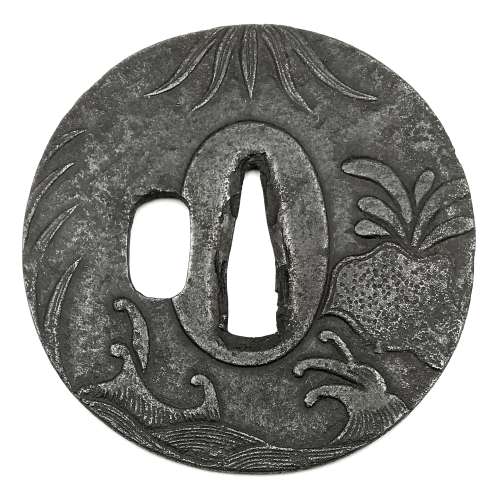 Round iron plate of grey colour decorated in low relief (sukidashi-bori) on the face with sea waves (both layered waves, seigaiha, and rough waves, araumi), sago palm (cycas revoluta, sotetsu), presumably orchid leaves (ran) - five of them - hanging from the above, and reeds (ashi), and on the back with waves (seigaiha only), rocks, chrysanthemums (kiku), clove (chori), reed, and presumably orchid leaves - three of them - hanging from the above. The kozuka-hitsu-ana was probably cut later. The plate is lacking the raised rim, typical for the kamakura-bori school. Muromachi period. Dimensions: Height: 76.8 mm, width: 76.1 mm, Thickness at seppa-dai: 3.3 mm, at rim 2.0 mm. Height of nakago-ana: 29 mm. Weight: 82.4 g. NBTHK certificate № 402152: Hozon - "Worthy of preservation". A similar (most probably the same) tsuba is illustrated and described at Butterfield & Butterfield. IMPORTANT JAPANESE SWORDS, SWORD FITTINGS AND ARMOR. Auction Monday, November 19th, 1979. Sale # 3063 under lot № 66. It describes the piece as following: “Kamakura bori work of the Muromachi period. Round thin plate with some small iron bones in the edge. Carved with design of plants (sego palm) rocks, and waves on the face. The back has half of two chrysanthemums, waves, clove, and sego palm leaves. The kozuka-hitsu has been added and later enlarged. A good typical example without the rim most have. Diameter: 7.7 cm., thickness 2.5 mm. Estimated price $100-200":
Round iron plate of grey colour decorated in low relief (sukidashi-bori) on the face with sea waves (both layered waves, seigaiha, and rough waves, araumi), sago palm (cycas revoluta, sotetsu), presumably orchid leaves (ran) - five of them - hanging from the above, and reeds (ashi), and on the back with waves (seigaiha only), rocks, chrysanthemums (kiku), clove (chori), reed, and presumably orchid leaves - three of them - hanging from the above. The kozuka-hitsu-ana was probably cut later. The plate is lacking the raised rim, typical for the kamakura-bori school. Muromachi period. Dimensions: Height: 76.8 mm, width: 76.1 mm, Thickness at seppa-dai: 3.3 mm, at rim 2.0 mm. Height of nakago-ana: 29 mm. Weight: 82.4 g. NBTHK certificate № 402152: Hozon - "Worthy of preservation". A similar (most probably the same) tsuba is illustrated and described at Butterfield & Butterfield. IMPORTANT JAPANESE SWORDS, SWORD FITTINGS AND ARMOR. Auction Monday, November 19th, 1979. Sale # 3063 under lot № 66. It describes the piece as following: “Kamakura bori work of the Muromachi period. Round thin plate with some small iron bones in the edge. Carved with design of plants (sego palm) rocks, and waves on the face. The back has half of two chrysanthemums, waves, clove, and sego palm leaves. The kozuka-hitsu has been added and later enlarged. A good typical example without the rim most have. Diameter: 7.7 cm., thickness 2.5 mm. Estimated price $100-200":
Butterfield & Butterfield, 1979. Sale # 3063, lot № 66.
-
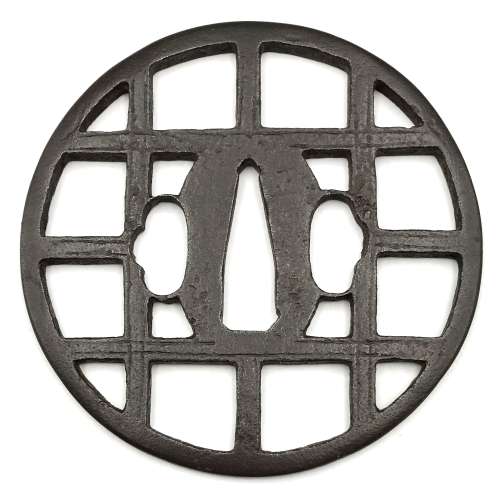 Iron tsuba of round form with design of lattice (kōshi-mon, 格子文) cut in openwork (sukashi), with low relief shallow linear carving along the bars. Well forged plate with brown-ish hue. To the right of nakago-ana there is a clear inscription of the character Shō (正), which is explained by Markus Sesko is follows: "The Shinsa obviously recognized more from the signature when having the tsuba in hand, i.e. they were confident to say it is signed "Shōami" but the rest is illegible (ika-fumei, 以下不明). That is, if they were just able to read the first character SHŌ (正) and saw that there were two more, most likely A (阿) and MI (弥), they would have put those character in boxes on the paper. Boxes around characters namely means that the character is not 100% legible but it can be assumed what it is." Momoyama or early Edo period. Dimensions: 85.9 mm diameter, 3.6 mm thickness at seppa-dai. Weight: 79 g. NBTHK certificate № 425069 with attestation: Hozon - "Worthy of preservation". A similar tsuba is presented at Japanese Sword Fittings from the R. B. Caldwell Collection. Sale LN4188 "HIGO". Sotheby's, 30th March 1994, №15. The description says: "A rare early Kamakura-bori tsuba. Nambokucho period (late 14th century). Of circular form, the dark plate carved and pierced with a gate design, the struts with double engraved lines. Unsigned. 8.5 cm." The lot was sold for 1,840 GBP.We have two possible explanations of the discrepancy between Sotheby's and Shinsa/Sesko attribution: 1) either Sotheby's or Shinsa/Sesko were wrong in their attribution or 2) these are two different pieces, one - Kamakura-bori from the 14th century and another - Shōami from 16th/17th century. Anyway, I would consider my piece as a Shōami tsuba of Momoyama - early Edo period, just for the sake of modesty.
Iron tsuba of round form with design of lattice (kōshi-mon, 格子文) cut in openwork (sukashi), with low relief shallow linear carving along the bars. Well forged plate with brown-ish hue. To the right of nakago-ana there is a clear inscription of the character Shō (正), which is explained by Markus Sesko is follows: "The Shinsa obviously recognized more from the signature when having the tsuba in hand, i.e. they were confident to say it is signed "Shōami" but the rest is illegible (ika-fumei, 以下不明). That is, if they were just able to read the first character SHŌ (正) and saw that there were two more, most likely A (阿) and MI (弥), they would have put those character in boxes on the paper. Boxes around characters namely means that the character is not 100% legible but it can be assumed what it is." Momoyama or early Edo period. Dimensions: 85.9 mm diameter, 3.6 mm thickness at seppa-dai. Weight: 79 g. NBTHK certificate № 425069 with attestation: Hozon - "Worthy of preservation". A similar tsuba is presented at Japanese Sword Fittings from the R. B. Caldwell Collection. Sale LN4188 "HIGO". Sotheby's, 30th March 1994, №15. The description says: "A rare early Kamakura-bori tsuba. Nambokucho period (late 14th century). Of circular form, the dark plate carved and pierced with a gate design, the struts with double engraved lines. Unsigned. 8.5 cm." The lot was sold for 1,840 GBP.We have two possible explanations of the discrepancy between Sotheby's and Shinsa/Sesko attribution: 1) either Sotheby's or Shinsa/Sesko were wrong in their attribution or 2) these are two different pieces, one - Kamakura-bori from the 14th century and another - Shōami from 16th/17th century. Anyway, I would consider my piece as a Shōami tsuba of Momoyama - early Edo period, just for the sake of modesty.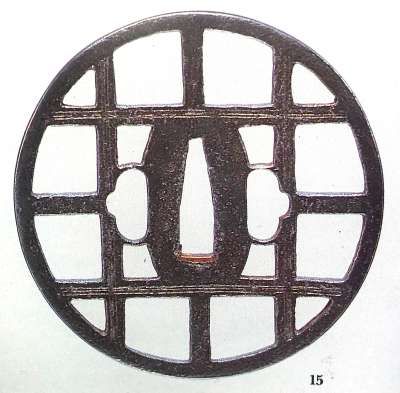
Caldwell Collection. Sotheby's 1994, №15.
-
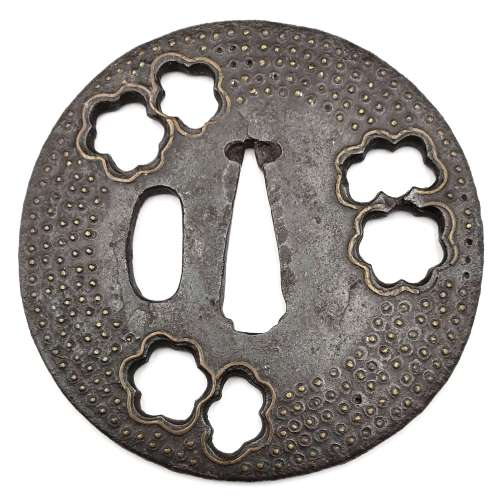 Iron tsuba of slightly elongated round form decorated with three pairs of snowflake-form small perforations (ko-sukashi), each outlined with brass wire; five concentric circular rows of dots inlaid in brass or copper ten-zōgan (some dots are missing). Hitsu-ana of oval form. Ōnin school. Unsigned. Late Muromachi period. Dimensions: 75.6 mm x74.6 mm x 3.0 mm. Weight: 78.0 g. Old NBTHK certificate (green paper): Tokubetsu Kicho - "Extraordinary Work". Unlike most Ōnin ten-zōgan tsuba this one does not have circular brass wire inlay inside the dots area; neither it has brass trim around seppa-dai or hitsu-ana.
Iron tsuba of slightly elongated round form decorated with three pairs of snowflake-form small perforations (ko-sukashi), each outlined with brass wire; five concentric circular rows of dots inlaid in brass or copper ten-zōgan (some dots are missing). Hitsu-ana of oval form. Ōnin school. Unsigned. Late Muromachi period. Dimensions: 75.6 mm x74.6 mm x 3.0 mm. Weight: 78.0 g. Old NBTHK certificate (green paper): Tokubetsu Kicho - "Extraordinary Work". Unlike most Ōnin ten-zōgan tsuba this one does not have circular brass wire inlay inside the dots area; neither it has brass trim around seppa-dai or hitsu-ana. -
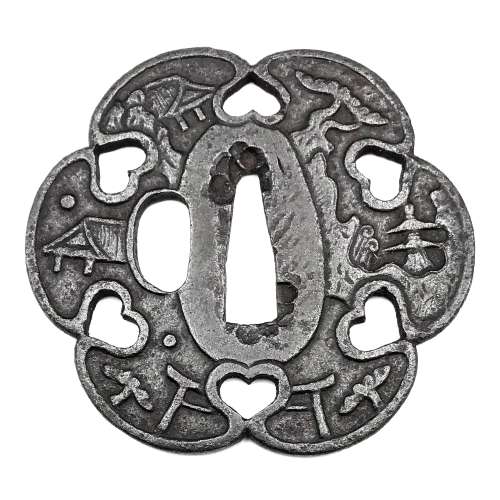 Iron tsuba of six-lobed (mutsu-mokkō-gata) form, with six wild boar's eye shape (inome) openings (sukashi). Hitsu-ana and the entire perimeter of tsuba have typical for this school raised rim. Lobes are decorated with landscape motifs in low relief carving (sukidashi-bori). On the obverse: A hut under a full moon, Shinto shrine gates (torii) with pines and a full moon, rocks, a large pine tree, and a temple (pagoda) surrounded by rocks and waves. On the reverse: waves, fishing boat, wild gees in flight under full moon, maple, hexagon (tortoiseshell, kikko) with a dot inside and a dot outside (inclusion/exclusion symbol), and chrysanthemum (the last two may be family crests, mon). Kamakura-bori school. Late Muromachi period (1514-1573). Height: 64.2 mm, width: 74.3 mm, Thickness at seppa-dai: 3.2 mm, at rim 2.6 mm. Weight: 62.8 g (light). NBTHK old green certificate №561: Tokubetsu Kicho - "Extraordinary Work". A look-a-like tsuba can be found at the Compton Collection, part II, pp. 14-15, №17, though his tsuba is more massive (80 x 84 x 4 mm).NBTHK paper says that the motif is Hakkei (八景), i.e. "Eight Views," so several interpretations are possible (the original Chinese ones, Omi Hakkei, etc.). However, most likely it is the 'Eight views of Omi' (近江八景 - 'Omi Hakkei'). Why the artist selected a 6-lobed form for depicting 8 views remains unclear, and thus we are in our right to raise the question whether the motif is indeed Hakkei. The term Omi hakkei (eight views of Omi) refers to painting or print sets which illustrate life on the shores of Lake Biwa in Omi (now Shiga Prefecture). The model for such paintings came from China, where, from the eleventh century onward, painters had produced eight views of the Hsiao and Hsiang lake areas of Hunan Province. The themes, which follow the original Chinese models, are: geese descending to land, returning fishing boats, clearing rain, a snow-covered evening landscape, the autumn moon, night rain, a temple bell at evening, and the glow of sunset. Japanese artists have also used the eight-theme approach for other parts of country - including cities - and applied it to subject matter other than landscapes. [Merrily Baird. Symbols of Japan. Thematic motifs in art and design. Rizzoli international publications, Inc., 2001, page 308-9]. Japan Encyclopedia by Louis Frédéric also mentions Omi Hakkei as "Eight landscapes of Omi", and states that this theme was often cited in poetry after 1500. It is likely that the tsuba in focus is designed under the influence of the theme popularity in the 16th century. The theme was effectively exploited by prominent ukiyo-e artists Suzuki Harunobu and Utagawa Hiroshige in the 18th and 19th century, respectively. These are the eight scenes of the theme (see Wikipedia):
Iron tsuba of six-lobed (mutsu-mokkō-gata) form, with six wild boar's eye shape (inome) openings (sukashi). Hitsu-ana and the entire perimeter of tsuba have typical for this school raised rim. Lobes are decorated with landscape motifs in low relief carving (sukidashi-bori). On the obverse: A hut under a full moon, Shinto shrine gates (torii) with pines and a full moon, rocks, a large pine tree, and a temple (pagoda) surrounded by rocks and waves. On the reverse: waves, fishing boat, wild gees in flight under full moon, maple, hexagon (tortoiseshell, kikko) with a dot inside and a dot outside (inclusion/exclusion symbol), and chrysanthemum (the last two may be family crests, mon). Kamakura-bori school. Late Muromachi period (1514-1573). Height: 64.2 mm, width: 74.3 mm, Thickness at seppa-dai: 3.2 mm, at rim 2.6 mm. Weight: 62.8 g (light). NBTHK old green certificate №561: Tokubetsu Kicho - "Extraordinary Work". A look-a-like tsuba can be found at the Compton Collection, part II, pp. 14-15, №17, though his tsuba is more massive (80 x 84 x 4 mm).NBTHK paper says that the motif is Hakkei (八景), i.e. "Eight Views," so several interpretations are possible (the original Chinese ones, Omi Hakkei, etc.). However, most likely it is the 'Eight views of Omi' (近江八景 - 'Omi Hakkei'). Why the artist selected a 6-lobed form for depicting 8 views remains unclear, and thus we are in our right to raise the question whether the motif is indeed Hakkei. The term Omi hakkei (eight views of Omi) refers to painting or print sets which illustrate life on the shores of Lake Biwa in Omi (now Shiga Prefecture). The model for such paintings came from China, where, from the eleventh century onward, painters had produced eight views of the Hsiao and Hsiang lake areas of Hunan Province. The themes, which follow the original Chinese models, are: geese descending to land, returning fishing boats, clearing rain, a snow-covered evening landscape, the autumn moon, night rain, a temple bell at evening, and the glow of sunset. Japanese artists have also used the eight-theme approach for other parts of country - including cities - and applied it to subject matter other than landscapes. [Merrily Baird. Symbols of Japan. Thematic motifs in art and design. Rizzoli international publications, Inc., 2001, page 308-9]. Japan Encyclopedia by Louis Frédéric also mentions Omi Hakkei as "Eight landscapes of Omi", and states that this theme was often cited in poetry after 1500. It is likely that the tsuba in focus is designed under the influence of the theme popularity in the 16th century. The theme was effectively exploited by prominent ukiyo-e artists Suzuki Harunobu and Utagawa Hiroshige in the 18th and 19th century, respectively. These are the eight scenes of the theme (see Wikipedia):
Compton Collection, part II, pp. 14-15, №17: Kamakura-bori tsuba, ca. 1450.
- Returning sails at Yabase (矢橋の帰帆) - Yabase. Yabase is an old harbour on the east side of the lake. Near the Tokaido, it was used for a shortcut to Otsu by boat.
- Evening glow at Seta (勢多(瀬田)の夕照) - The Chinese Bridge at Seta. The long bridge across the Seta was used by the Tokaido. In the background the "Fuji of Omi", the Mikamiyama. It is just above 400 m, but indeed well visible.
- Autumn moon at Ishiyama (石山の秋月) - Ishiyama Temple. The Ishiyamadera was located on a hillside next to the Seta River. It got his name form the strange rocks on which it is built, partly on supporting beams. A hut at the upper end of the site allows a view of the lake, and the moon.
- Clear breeze at Awazu (粟津の晴嵐) - Awazuhara. Awazu is well known for its pine wood, Awazu-ga-hara.
- Evening bell at Miidera (三井晩鐘) - Mii-dera. Miidera temple was built in the 8th century. Its famous bell is one of the "Three bells of Japan", the other two being those at Byoodo-in, Uji and at Jingoji, Kyoto.
- Evening rain at Karasaki (唐崎の夜雨) - Karasaki Shrine. Karasaki is a small cape with a single large pine tree, a hitsu-matsu.
- Wild geese returning home at Katata (堅田の落雁) - Ukimido. Alighting geese cannot be seen always, however the little temple near Katata in the square hōkyō-style, detached from the lakeside, connected by a bridge. The first part of the name uki is the same as in Ukiyo-e, meaning floating. Midō means temple.
- Evening snow at Hira (比良の暮雪) - Hira Mountains. The Hira mountains on the west side of the lake experience the hard winter, when the winter monsoon brings much snow from the continent.
-
 Iron tsuba of round form decorated with eight roundels - circular emblems of flowers and/or family crests (mon) made of cast brass, pierced and chiseled in kebori, and with flat brass inlay (hira-zōgan) of vines or seaweed all over the plate. Hitsu-ana outlined in brass. Four positive silhouette roundels are 3-, 4-, 5-, and 6- pointing crests/flowers; four negative silhouette roundels are bellflower, cherry blossom, and suhama. Yoshirō school (Kaga-Yoshirō). The Momoyama or early Edo period, beginning of 17th century. Size: diameter 77 mm, thickness 3,8 mm
Iron tsuba of round form decorated with eight roundels - circular emblems of flowers and/or family crests (mon) made of cast brass, pierced and chiseled in kebori, and with flat brass inlay (hira-zōgan) of vines or seaweed all over the plate. Hitsu-ana outlined in brass. Four positive silhouette roundels are 3-, 4-, 5-, and 6- pointing crests/flowers; four negative silhouette roundels are bellflower, cherry blossom, and suhama. Yoshirō school (Kaga-Yoshirō). The Momoyama or early Edo period, beginning of 17th century. Size: diameter 77 mm, thickness 3,8 mm -
 Well-forged iron plate of round shape (maru-gata) is decorated with water weeds or arabesque (karakusa) in flat brass inlay (hira-zōgan) all over and eight family crests (mon) of round form in cast brass with delicate linear carving (kebori) and openwork (sukashi). Crests represent: [at 9 hours] three counter-clockwise commas or swirls (tomoe); [at 10:30] plum blossom (ume); [at 12:00, 1:130, and 7:30] - stylized flower made by cutting out five suhama symblos (flower-shaped suhama); [at 3:00] bellflower (kikyō); [at 4:30] seven-star crest (shichiyō-mon); [at 6:00] cherry blossom (sakura). Brass-trimmed ryo-hitsu. Copper sekigane. Yoshirō school. Momoyama or early Edo period, end of the 16th to first half of the 17th century (1574-1650). Inscription on seppa-dai: 八幡 - Hachiman. Size: height 89.6 mm, width 89.3 mm, thickness at seppa-dai 3,0 mm. Weight 129.7 g. NBTHK certificate № 4007685, June 27, 2015: HOZON (Worthy of Preservation). As for the inscription, Nihonto Message Board blog discussion provides the following explanation of the inscription: "An expression of conviction as to being the best under the sun". On the other hand, there may be more in this confluence of symbols: the tomoe crest at 9:00 is "the kamon of Hachiman, the war god" [Family Crests of Japan; Stone Bridge Press, Berkeley, CA, 2007, p. 108]. The character 八 in the inscription cut stronger than the other kanji, and may be by a different hand in different time. 八 (hachi, eight): "The numeral eight was appreciated because its shape broadens toward the bottom, symbolizing eternal expansion" [ibid, p. 119]. It may be said that this tsuba is dedicated to Hachiman. Other crests (suhama, bellflower, seven-stars, plum and cherry blossoms) collectively allude to "good old times" when Fijiwara and Taira clans were in full bloom. Markus Sesko believes that the inscriptions reads: Hachiman: "the inscription is/was HACHIMAN (八幡), the God of War and a relatively popular inscription for tsuba, swords and armor." Elliott Long and Robert Haynes provide the following explanation of the inscription: "...hachi is correct and represents the name of the HACHI SHRINE. The inscription reads 'YAWATA' which is the name of the mountain in Mino Province where the HACHI Shrine is located". Details on Hachiman Shrine in Yawata (八幡市) can be found elsewhere, including Historical and geographical dictionary of Japan by Edmond Papinot. Van Ham auction house provides the following description: MON-SUKASHI TSUBA. MARUGATA. Japan. Momoyama period. Yoshiro school. Iron with inlays of brass. In hira-zogan technique with kebori engraving eight different family emblems (mon). An old inscription is dedicated to the deity Hachiman. D.4.5mm, Ø 8.3cm. Condition A/B. Supplement: Wooden box and NBTHK certificate.
Well-forged iron plate of round shape (maru-gata) is decorated with water weeds or arabesque (karakusa) in flat brass inlay (hira-zōgan) all over and eight family crests (mon) of round form in cast brass with delicate linear carving (kebori) and openwork (sukashi). Crests represent: [at 9 hours] three counter-clockwise commas or swirls (tomoe); [at 10:30] plum blossom (ume); [at 12:00, 1:130, and 7:30] - stylized flower made by cutting out five suhama symblos (flower-shaped suhama); [at 3:00] bellflower (kikyō); [at 4:30] seven-star crest (shichiyō-mon); [at 6:00] cherry blossom (sakura). Brass-trimmed ryo-hitsu. Copper sekigane. Yoshirō school. Momoyama or early Edo period, end of the 16th to first half of the 17th century (1574-1650). Inscription on seppa-dai: 八幡 - Hachiman. Size: height 89.6 mm, width 89.3 mm, thickness at seppa-dai 3,0 mm. Weight 129.7 g. NBTHK certificate № 4007685, June 27, 2015: HOZON (Worthy of Preservation). As for the inscription, Nihonto Message Board blog discussion provides the following explanation of the inscription: "An expression of conviction as to being the best under the sun". On the other hand, there may be more in this confluence of symbols: the tomoe crest at 9:00 is "the kamon of Hachiman, the war god" [Family Crests of Japan; Stone Bridge Press, Berkeley, CA, 2007, p. 108]. The character 八 in the inscription cut stronger than the other kanji, and may be by a different hand in different time. 八 (hachi, eight): "The numeral eight was appreciated because its shape broadens toward the bottom, symbolizing eternal expansion" [ibid, p. 119]. It may be said that this tsuba is dedicated to Hachiman. Other crests (suhama, bellflower, seven-stars, plum and cherry blossoms) collectively allude to "good old times" when Fijiwara and Taira clans were in full bloom. Markus Sesko believes that the inscriptions reads: Hachiman: "the inscription is/was HACHIMAN (八幡), the God of War and a relatively popular inscription for tsuba, swords and armor." Elliott Long and Robert Haynes provide the following explanation of the inscription: "...hachi is correct and represents the name of the HACHI SHRINE. The inscription reads 'YAWATA' which is the name of the mountain in Mino Province where the HACHI Shrine is located". Details on Hachiman Shrine in Yawata (八幡市) can be found elsewhere, including Historical and geographical dictionary of Japan by Edmond Papinot. Van Ham auction house provides the following description: MON-SUKASHI TSUBA. MARUGATA. Japan. Momoyama period. Yoshiro school. Iron with inlays of brass. In hira-zogan technique with kebori engraving eight different family emblems (mon). An old inscription is dedicated to the deity Hachiman. D.4.5mm, Ø 8.3cm. Condition A/B. Supplement: Wooden box and NBTHK certificate. -
 Shingen school (or style) tsuba of round form with an iron core of spoked-wheel shape, with its centre covered with a copper plate decorated with star-shaped punch marks. From this copper plate outward, the body is formed by brass and copper wire (flat and twisted) in a weave pattern. Both hitsu-ana are outlined in brass with a raised rim. Copper sekigane. Unsigned. Edo period, 18th century. SOLD Height: 98.0 mm, Width: 97.4 mm, Thickness at seppa-dai: 6.0 mm. Weight: 290 g. NBTHK certificate №436696: 'Hozon' attestation. Citing "JAPANESE SWORD-MOUNTS IN THE COLLECTIONS OF FIELD MUSEUM" by Helen C. Gunsaulus, Assistant Curator of Japanese Ethnology. 61 plates. Berthold Laufer, Curator of Anthropology. Field Museum of Natural History, Publication 216, Anthropological Series, Volume XVI; Chicago, 1923; p.45: "An unusual group of tsuba popular in the late sixteenth century and afterwards is made up of those guards known as Shingen tsuba, a name which was derived from a sixteenth-century warrior, Takeda Shingen (Takeda Harunobu, 1521-73), who is said to have preferred this style of guard, as it combined strength and lightness. Under the category of "Shingen", four different types abd generally listed, though a fifth appears in the drawings in the Boston Catalogue of Okabe Kakuya "Japanese Sword Guards" (p. 21). It is square, that form which is said to have been used in Ashikaga days for scaling walls, the sword having been set up as a step. [...] The following descriptions include, however, the Shingen tsuba usually met with.
Shingen school (or style) tsuba of round form with an iron core of spoked-wheel shape, with its centre covered with a copper plate decorated with star-shaped punch marks. From this copper plate outward, the body is formed by brass and copper wire (flat and twisted) in a weave pattern. Both hitsu-ana are outlined in brass with a raised rim. Copper sekigane. Unsigned. Edo period, 18th century. SOLD Height: 98.0 mm, Width: 97.4 mm, Thickness at seppa-dai: 6.0 mm. Weight: 290 g. NBTHK certificate №436696: 'Hozon' attestation. Citing "JAPANESE SWORD-MOUNTS IN THE COLLECTIONS OF FIELD MUSEUM" by Helen C. Gunsaulus, Assistant Curator of Japanese Ethnology. 61 plates. Berthold Laufer, Curator of Anthropology. Field Museum of Natural History, Publication 216, Anthropological Series, Volume XVI; Chicago, 1923; p.45: "An unusual group of tsuba popular in the late sixteenth century and afterwards is made up of those guards known as Shingen tsuba, a name which was derived from a sixteenth-century warrior, Takeda Shingen (Takeda Harunobu, 1521-73), who is said to have preferred this style of guard, as it combined strength and lightness. Under the category of "Shingen", four different types abd generally listed, though a fifth appears in the drawings in the Boston Catalogue of Okabe Kakuya "Japanese Sword Guards" (p. 21). It is square, that form which is said to have been used in Ashikaga days for scaling walls, the sword having been set up as a step. [...] The following descriptions include, however, the Shingen tsuba usually met with.- So-called Mukade ("centipede") tsuba are made of iron in which a centepede is inlaid in brass or copper wire. Mukade tsuba of Myōchin and Umetada warkmanship have been found with the inscription, "Made to the taste of Takeda Shingen".
- There are those of solid iron, with need centers of brass, to the edges of which is affixed a weaving of brass and copper wires which is bound to the foundation disk by a rim, usually decorated simply.
- Another type is of solid iron, bored at intervals and laced with braided or twisted wires of copper and brass.
- The fourth type is a chrysanthemoid form, chiselled in open work and laced or woven tightly with copper and brass wire."

Compton Collection, Part II, p.p. 26-27, №54.
-
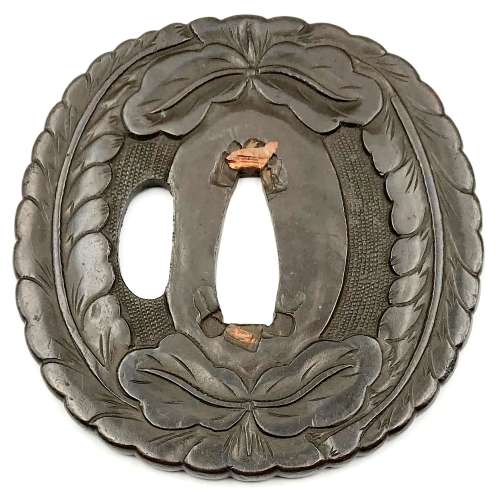 A yamagane (unrefined copper) ko-kinko tsuba of slightly elongated round form with design of wisteria carved in sculptural relief (nikubori). Copper sekigane. Unsigned. Muromachi period, likely the 16th century.
A yamagane (unrefined copper) ko-kinko tsuba of slightly elongated round form with design of wisteria carved in sculptural relief (nikubori). Copper sekigane. Unsigned. Muromachi period, likely the 16th century.Size: 74.3 x 71.8 x 3.2 mm.
NBTHK certificate №4003986: Hozon (worthy preservation). In custom wooden box.


